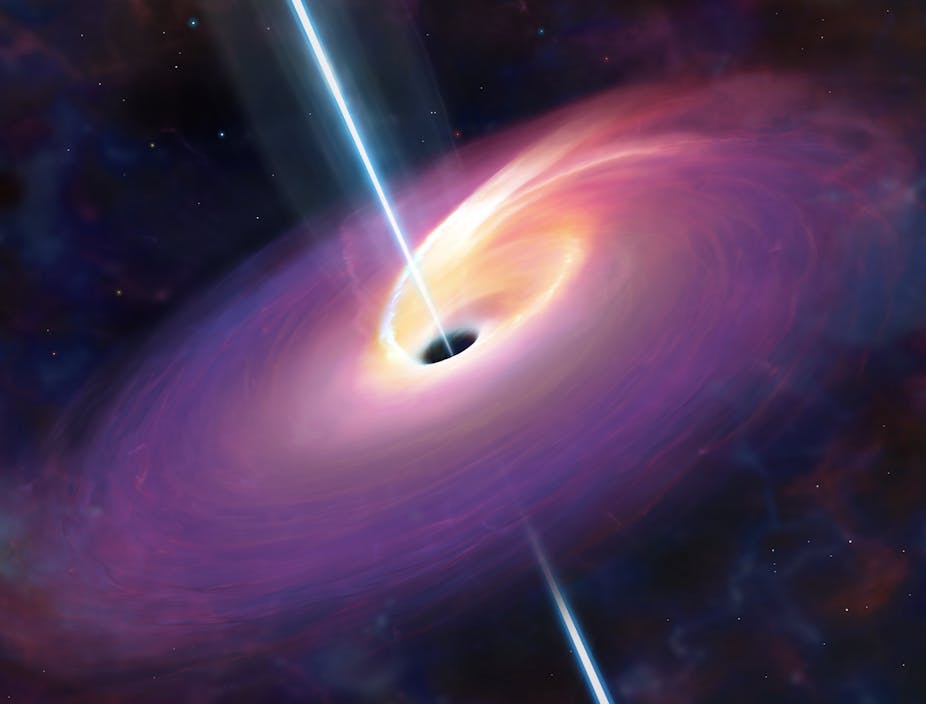Some 3.8 billion years ago a star in the constellation of Draco wandered a little too close to a nearby black hole.
The star was violently torn apart by the black hole’s tidal forces, creating two massive beams of radiation in the process.
One of these beams of radiation was detected by astronomers back in March but it took until this week to confirm that the nearby black hole was to blame.
This dramatic event is just one example of a changing universe; a universe in which some objects are being born and some are being destroyed.
The study of these changes is the realm of “transient astronomy”.
A history of change
Humans have always been fascinated by the changing sky above us. Ancient cultures around the world recorded the mysterious appearance of “guest stars”, investing them with deep spiritual significance.
Transient astronomy is an extension of this millennia-old fascination; a study of change and of the massive releases of energy caused by a number of astronomical phenomena:
- stars being created
- stars exploding as they die
- super-massive black holes that power some galaxies
- strong magnetic fields that cause flares on the surface of stars
- a whole host of exotic objects bursting and flickering, appearing or disappearing.
The energy burst detected in March of this year is only the latest in a series of exciting transient events.
On March 19 2008, NASA’s Swift satellite detected a powerful burst of energy caused by the death of a massive star approximately 7.5 billion years ago.
This burst of high-energy, low-wavelength gamma radiation was so bright that a keen observer looking to the constellation of Boötes at that moment would have seen it with their naked eye.
As with the explosion in the Draco constellation, the energy from the Boötes burst was channelled into two narrow jets along the star’s rotation axis.
One of these jets happened to point almost directly towards us, producing the very bright emission seen from Earth.
The problem with gamma-rays
Gamma-ray bursts are some of the most extreme events in the universe. They provide astronomers with a natural laboratory for investigating fundamental physics.
Unfortunately though, the narrow jets that produce bright emissions also limit our ability to discover new gamma-ray bursts: we can only see them if the jets are pointed towards us.
As a result, we have only detected a small fraction of the total population of gamma-ray bursts.
But thanks to a range of new radio telescopes, we might be able to vastly increase the number of gamma-ray bursts we are able to discover.

Radio to the rescue
Radio astronomy works at the opposite end of the electromagnetic spectrum to gamma-ray astronomy, and detects low-energy, long-wavelength radiation.
Radio waves can travel through space to Earth virtually unaffected by any gas or dust that might be in the way, giving us a unique picture of the distant universe.
This ability to pass through gas and dust can help us to make sense of gamma-ray bursts, even when an energy beam isn’t pointed directly at Earth. How?
Well, following an initial explosion, a shock travels out from the core of the dying star, producing what is known as an “afterglow”. This afterglow emanates equally in all directions and so can be detected on Earth regardless of which way the jets were pointed.
Consequently, we should be able to detect radio waves from afterglows even when we don’t know where or when the original explosion has occurred.
In order to detect a greater number of gamma-ray bursts, we would need to constantly scan the sky, looking for things that have appeared or disappeared since our last observation.
Scanning the whole sky on a regular basis is very time consuming because, ideally, we want breadth and depth: we need a telescope that can see large patches of the sky at once while also being very sensitive to faint and distant astronomical objects.
Until recently, radio telescopes have only provided either depth or breadth, not both.
Generation Next
Fortunately, a new generation of radio telescopes is coming along that will allow us to survey the skies for transient and variable radio sources for the first time.
In fact, there are a number of such telescopes being built around the world:
- the Australian Square Kilometre Array Pathfinder (ASKAP) which is currently under construction in Western Australia.
- the Low Frequency Array for Astronomy (LOFAR) which is being commissioned in the Netherlands
- the Karoo Array Telescope (MeerKAT) which is being built in South Africa
Each of these telescopes has a range of scientific goals, but in each case, one of their main goals is to conduct large surveys to study transient radio sources.
With ASKAP we will be able to produce a new image every five seconds, allowing us to look for new transient objects in “real time”, catching events as they occur.
After millennia of observing transient sources in optical light we are entering a new age of radio astronomy. These exciting new telescopes – in conjunction with sophisticated software – will allow us to understand more about gamma-ray bursts, and discover new populations of astronomical transients.
Best of all, we will be able to see them even if they are hidden behind clouds of dust in distant galaxies.

